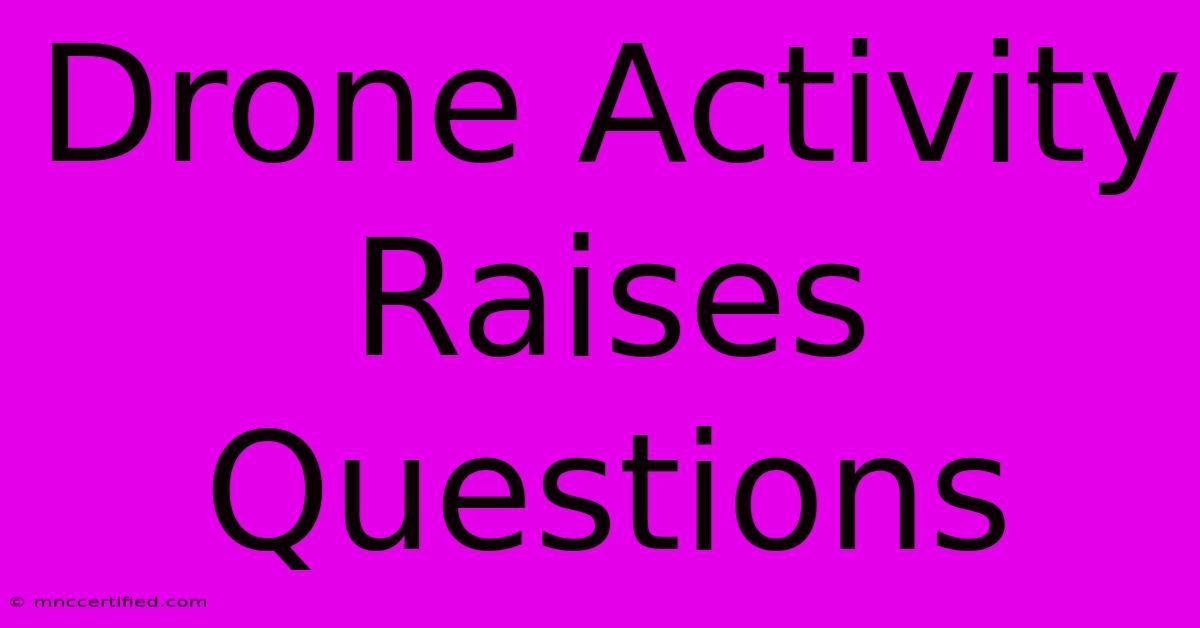Drone Activity Raises Questions

Table of Contents
Drone Activity Raises Questions: Privacy, Safety, and the Future of Flight
Drone technology has exploded in popularity, offering incredible capabilities for photography, videography, delivery services, and even search and rescue operations. However, this rapid expansion has also raised significant concerns regarding privacy, safety, and the future of airspace regulation. This article delves into these key issues, examining the complexities and potential solutions surrounding the increasingly ubiquitous drone.
Privacy Concerns: A Bird's-Eye View into Personal Space
One of the most pressing concerns surrounding drone activity is the potential invasion of privacy. Drones equipped with high-resolution cameras can capture images and videos of individuals in their homes and private property without their knowledge or consent. This raises serious ethical and legal questions, particularly regarding the boundaries of surveillance and the right to privacy. The ease of access to drone technology further exacerbates the issue, making it simpler for individuals to conduct unauthorized surveillance.
Key Privacy Questions:
- What legal protections are in place to prevent unauthorized drone surveillance? Current legislation varies widely across jurisdictions, leaving many loopholes and ambiguities.
- How can technology be used to mitigate privacy concerns, such as anonymization or blurring techniques? Technological solutions are crucial, but they need to be balanced with the practical needs of drone operators.
- What role should public awareness and education play in addressing privacy concerns? Educating the public on responsible drone use and the implications of their actions is vital.
Safety Hazards: Navigating the Skies Responsibly
Beyond privacy, drone activity also presents significant safety challenges. Collisions with aircraft, power lines, and even people are potential hazards, particularly in densely populated areas or uncontrolled airspace. The potential for misuse, such as using drones for malicious purposes, adds another layer of complexity to safety concerns.
Addressing Safety Concerns:
- Enhanced regulatory frameworks: Stricter regulations regarding drone operation, including licensing, registration, and flight restrictions, are essential for mitigating safety risks.
- Improved technology: Developments in obstacle avoidance systems, geofencing, and remote identification technology can significantly enhance drone safety.
- Pilot training and education: Comprehensive training programs for drone operators are vital to ensure they understand safe operating procedures and regulations.
The Future of Drone Regulation: Balancing Innovation and Control
The rapid advancements in drone technology necessitate a proactive approach to regulation. Striking a balance between fostering innovation and ensuring public safety and privacy is crucial. This requires a collaborative effort involving government agencies, drone manufacturers, and the public.
Key Considerations for the Future:
- International cooperation: Harmonizing drone regulations across borders is essential for addressing the global nature of drone operations.
- Adaptability to technological advancements: Regulations need to be flexible enough to adapt to the rapid pace of technological innovation in the drone industry.
- Public input and engagement: Involving the public in the development and implementation of drone regulations is crucial for ensuring that these regulations are effective and socially acceptable.
Conclusion:
Drone technology offers immense potential benefits across various sectors. However, the associated privacy and safety concerns necessitate a careful and considered approach to regulation. By addressing these issues proactively and fostering a collaborative environment, we can harness the full potential of drones while mitigating their risks and ensuring responsible use for the benefit of all. The future of drone activity hinges on our ability to navigate these complex challenges effectively.

Thank you for visiting our website wich cover about Drone Activity Raises Questions. We hope the information provided has been useful to you. Feel free to contact us if you have any questions or need further assistance. See you next time and dont miss to bookmark.
Featured Posts
-
Trump Taps Linda Mc Mahon For Education
Nov 20, 2024
-
Live Stream Argentina Vs Peru World Cup
Nov 20, 2024
-
Kingdom Hearts Disney Trading Pin
Nov 20, 2024
-
Investment Properties San Antonio
Nov 20, 2024
-
State Farm Insurance License Test
Nov 20, 2024